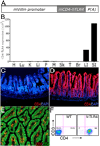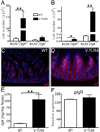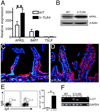Toll-like receptor signaling in small intestinal epithelium promotes B-cell recruitment and IgA production in lamina propria
- PMID: 18522803
- PMCID: PMC2598776
- DOI: 10.1053/j.gastro.2008.04.020
Toll-like receptor signaling in small intestinal epithelium promotes B-cell recruitment and IgA production in lamina propria
Abstract
Background & aims: Several lines of evidence support a role for Toll-like receptor (TLR) signaling to protect the intestine from pathogenic infection. We hypothesized that TLR signaling at the level of the intestinal epithelium is critical for mucosal immune responses.
Methods: We generated transgenic mice that express a constitutively active form of TLR4 in the intestinal epithelium (V-TLR4 mice). Lamina propria cellularity was evaluated by immunostaining and flow cytometry. Immunoglobulin (Ig) A levels in the stool and serum were measured by enzyme-linked immunosorbent assay. Chemokine and cytokine expression were analyzed by quantitative polymerase chain reaction and enzyme-linked immunosorbent assay.
Results: V-TLR4 transgenic mice reproduced normally and had a normal life span. Constitutive activity of TLR4 in the intestinal epithelium promoted recruitment of B cells and an increase in fecal IgA levels. Intestinal epithelial cells of V-TLR4 mice expressed higher levels of CCL20 and CCL28, chemokines known to be involved in B-cell recruitment, and of a proliferation-inducing ligand (APRIL), a cytokine that promotes T-cell-independent class switching of B cells to IgA. The changes in B-cell numbers and IgA levels were blocked by simultaneous expression in intestinal epithelial cells of M3, a herpes virus protein that binds and inhibits multiple chemokines.
Conclusions: TLR signaling in the intestinal epithelial cells significantly elevated the production of IgA in the intestine. This effect was mediated by TLR-induced expression of a specific set of chemokines and cytokines that promoted both recruitment of B cells into the lamina propria and IgA class switching of B cells.
Conflict of interest statement
Statement: There is no conflict of interest to disclose
Figures







Comment in
-
Guardians of the gut: newly appreciated role of epithelial toll-like receptors in protecting the intestine.Gastroenterology. 2008 Aug;135(2):351-4. doi: 10.1053/j.gastro.2008.06.064. Epub 2008 Jul 11. Gastroenterology. 2008. PMID: 18619968 No abstract available.
References
-
- Shimada S, Kawaguchi-Miyashita M, Kushiro A, Sato T, Nanno M, Sako T, Matsuoka Y, Sudo K, Tagawa Y, Iwakura Y, Ohwaki M. Generation of polymeric immunoglobulin receptor-deficient mouse with marked reduction of secretory IgA. J Immunol. 1999;163:5367–5373. - PubMed
-
- He B, Xu W, Santini PA, Polydorides AD, Chiu A, Estrella J, Shan M, Chadburn A, Villanacci V, Plebani A, Knowles DM, Rescigno M, Cerutti A. Intestinal bacteria trigger T cell-independent immunoglobulin A(2) class switching by inducing epithelial-cell secretion of the cytokine APRIL. Immunity. 2007;26:812–826. - PubMed
-
- Hoffmann JA, Kafatos FC, Janeway CA, Ezekowitz RA. Phylogenetic perspectives in innate immunity. Science. 1999;284:1313–1318. - PubMed
Publication types
MeSH terms
Substances
Grants and funding
LinkOut - more resources
Full Text Sources
Other Literature Sources
Molecular Biology Databases
Miscellaneous

